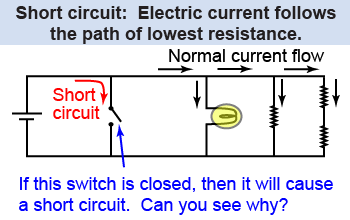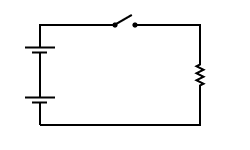|
An electric circuit is a conducting path through which electric current can flow. You make a circuit whenever you plug in an electric appliance or light. The need to create a complete circuit is why plugs have at least two wires—one for the current to flow out of the wall socket and one for the current to flow back in again. Naturally occurring electric circuits are found in nerves in your body and the pathways of lightning. 
|

|
A circuit diagram is a compact graphical tool that shows all the elements and their connections in an electrical circuit. Each circuit element—such as a wire, switch, battery, lamp, resistor, or fuse—has a unique symbol. The electrical symbol for each component has been standardized so that an electrical engineer can design a schematic drawing for a circuit without using pictures of the actual devices. 
|

|
A closed circuit includes at least one continuous closed path of a conductor, such as a wire, allowing electric current to flow. An open circuit is a path in which the connection is broken in at least one place in the loop, preventing the flow of current. In the circuits illustrated above, the switch opens or closes the circuit. A switch is a useful device because it allows you to easily and safely control the flow of current. A knife-blade switch opens or closes a circuit when you raise or lower the handle, respectively. 
|
 Closed circuits always include some device, such as a light bulb, that uses electrical energy. Accidentally connecting a wire directly between the terminals of a battery creates a short circuit. Without any device to dissipate electrical energy, a short circuit may cause a runaway flow of electric current. Short circuits should be avoided.
Closed circuits always include some device, such as a light bulb, that uses electrical energy. Accidentally connecting a wire directly between the terminals of a battery creates a short circuit. Without any device to dissipate electrical energy, a short circuit may cause a runaway flow of electric current. Short circuits should be avoided. 
 |
The circuit above was designed with a complicated set of resistors and lamp. When the switch is open, current flows through the resistors and lamp—and the lamp illuminates—because those are the only possible paths. When the switch is closed, however, it causes a short circuit. The path that has the switch has virtually no resistance, causing all the current to flow through that path and bypass the resistors and lamp—causing the lamp to turn off. 
|
Draw a circuit made up of two batteries, a switch, and a resistor, all connected in series (a single loop).
 |


|
| |
|

